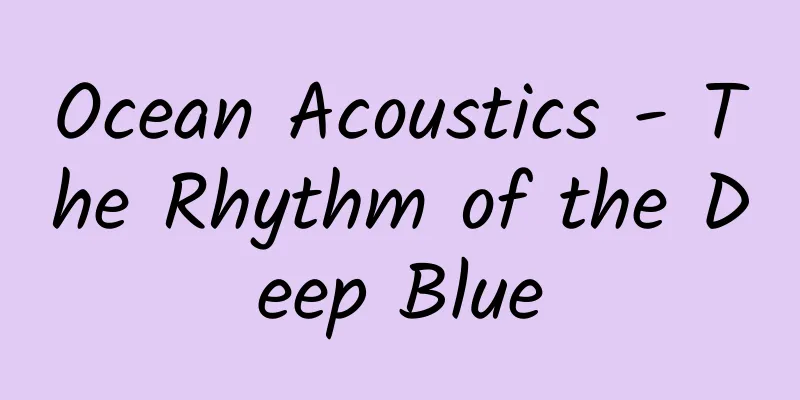Ocean Acoustics - The Rhythm of the Deep Blue

|
Produced by: Science Popularization China Author: Guo Zheng (East China Sea Research Station, Institute of Acoustics, Chinese Academy of Sciences) Producer: China Science Expo "Listen, the sound of the sea crying..." Have you ever wondered what kind of sounds are hidden beneath that beautiful deep blue? In scientific research, "what, why, and how" is a common and effective way of thinking. If we use this way of thinking to deconstruct ocean acoustic research, what conclusions can we draw? What is Ocean Acoustics? Marine acoustics is an important branch of modern acoustics and a comprehensive cutting-edge technical science that mainly studies the generation, propagation and reception of sound waves in the ocean. How do you understand this sentence? We can assume that there are two people, Xiao A and Xiao B. Xiao A claps his hands, and Xiao B hears the sound of Xiao A clapping his hands. In this scenario, our research results are: Generation of sound waves: Little A clapped his hands. Propagation of sound waves: from little A's hand to little B's ear, passing through the air (which we call the propagation medium). Reception of sound waves: The disturbance of sound waves propagates into little B's ears, causing the eardrum to vibrate. After the vibration is transmitted to the inner ear, it is converted into bioelectric signals, which are then processed by the auditory nervous system and received by little B's brain. Figure 1 Schematic diagram of ear structure (Image source: Nipic.com https://www.nipic.com/show/22042820.html) In this way, analogous to the study of ocean acoustics, we can make the following enumeration in the same form as above: Generation of sound waves in the ocean: We know that sound is generated by the vibration of objects. So, all vibrations in the ocean, including ship navigation, other human activities, the calls of marine life, submarine crust movement and volcanic eruptions, etc., create the generation of sound waves in the ocean. Figure 2 Sound waves in the ocean (Image source: Veer Gallery) Propagation of sound waves in the ocean: We know that the propagation of sound waves requires a medium, and sound cannot be transmitted in a vacuum. In the ocean, sound waves usually propagate in the seawater, and sometimes propagate along the seabed. Receiving sound waves in the ocean: In daily life, when we need to receive a certain sound signal, such as singing, we will use a microphone. In the ocean, we will use a special "microphone" designed for underwater use (we call it a hydrophone), so that we can easily receive sound waves in the ocean. The science that studies the generation, propagation and reception of sound waves in the ocean is called ocean acoustics. Figure 3 Hydrophone (Image source: Teledyne Marine http://www.teledynemarine.com/reson-tc-4032) Why study ocean acoustics? As an interdisciplinary subject, acoustics is inextricably linked to every aspect of our lives. For example, headphones and speakers belong to the research scope of electroacoustics; architectural acoustics studies how to create better auditory effects in theaters and auditoriums; the smart speakers we use in daily life also use voice acoustics, and so on. So what kind of "collision" will occur when acoustics meets the ocean? We know that about 70.8% of the Earth's surface is covered by water, most of which is ocean. As the importance of the ocean increases, humans need to have a deeper understanding of the ocean. By studying the laws of sound wave generation, propagation and reception in the ocean, ocean acoustics can serve as the "eyes and ears" of humans when exploring the ocean, helping humans to better understand the ocean. For example, people have developed a series of equipment by imitating the echo detection of animals such as bats and dolphins, and have also used echo detection to detect fish and seabed topography. In the military field, sonar equipment is also widely used to find the location of underwater submarines. Figure 4 Fish finder - used to detect fish schools (Image source: Matsutec http://www.matsutec.cn/products_info.php?id=234) Figure 5 Side-scan sonar - used to detect seabed topography (Photo source: Beijing Haizhuo https://www.sohu.com/a/349110652_743632) How to study ocean acoustics As we mentioned earlier, ocean acoustics is an important means for humans to understand and know the ocean as the "eyes and ears" of humans when exploring the ocean. So how do we conduct ocean acoustic research? Like other branches of physics such as light, electricity, and force, acoustics also belongs to physics. Naturally, like other branches of physics, it is a science that emphasizes experiments. Modern scientific research will go through two stages before the experiment: theoretical derivation and computer simulation. Ocean acoustics is no exception. As a direction in acoustics, ocean acoustics also attaches great importance to experiments. In ocean acoustic experiments, we usually focus on the measurement of sound waves themselves, including using the hydrophone mentioned above to record the sound in the water, and also measure physical quantities such as temperature and salinity that affect sound propagation, usually using instruments such as CTD (temperature-salinity-depth meter) and XBT (expendable temperature-depth meter), and then obtain the sound wave propagation speed at different depths. Finally, through this information related to ocean acoustics, we build our understanding of the marine environment. Figure 6 XBT (used to measure the speed of sound wave propagation at different depths) (Photo source: Donghai Station of Institute of Acoustics, Chinese Academy of Sciences) Human beings have never lacked the determination and courage to explore the unknown. From the "voice of the sea", we can better recognize and understand the ocean, and leave the footprints of human beings' diligent pursuit in this beautiful deep blue. Editor: Sun Chenyu References: [1] Wang Dezhao, Shang Erchang. Hydroacoustics[M]. Beijing: Science Press, 1981. [2] Liu Bosheng, Lei Jiayu. Principles of Hydroacoustics (Second Edition)[M]. Harbin: Harbin Engineering University Press, 2009. [3]Ross D. Mechanics of Underwater Noise. Oxford: Pergamon, 1976. |
Recommend
More than 20 car brands have connected to the DeepSeek big model, why are NIO, Xiaomi, Huawei and Li Auto not included?
Facing DeepSeek, the reactions of major Chinese a...
Zhengda Anatomy [Daily explanation of muscle pain in the whole body]
Zhengda Anatomy [Daily Explanation of Muscle Pain...
The most concise photovoltaic science popularization in history is here
"Photovoltaic will usher in an explosive per...
Jiucai e-commerce · Lao Tao will help you easily create a hit product and make money from Pinduoduo
Jiucai e-commerce · Lao Tao will help you easily ...
Optimize your information flow by taking these two steps and the effect will increase!
Today, we will use actual cases to further analyz...
From BAT mini programs to mobile phone manufacturers' quick apps: they look similar, but each has its own pain points
[[237510]] Image source: Visual China According t...
Swift version of infinite slideshow scrolling
Source code introduction: Swift version of slides...
A 6.2-magnitude earthquake occurred in Tainan, Taiwan, and many places in Fujian and Guangdong felt the tremors! Once again, we remind you that earthquake warning is very important!
The China Earthquake Networks Center officially d...
Which Google products have more than 1 billion users?
[[153365]] Do you want to know how big Google has...
How to create highly sticky products? Use these 3 models!
What is CLV? Those who make products must underst...
The new version of iMessage is an invisible browser in iOS 10
Just as public market investors are very optimist...
TechInsights: Chinese suppliers will dominate the global IoT module & gateway market in 2022
A recent research report released by TechInsights...
A new way for family interaction: "Sports Plus OL" Bodhi tennis match "smash" experience
Screen: operate: Sound Effects: Plot: Experience:...
2023 Enterprise Digital Transformation Capability Survey
The digital transformation of an enterprise is a ...
Mobei SEO course tenth phase basic class quick start course plus advanced course
Getting Started: A First Look at SEO Purchase hos...









